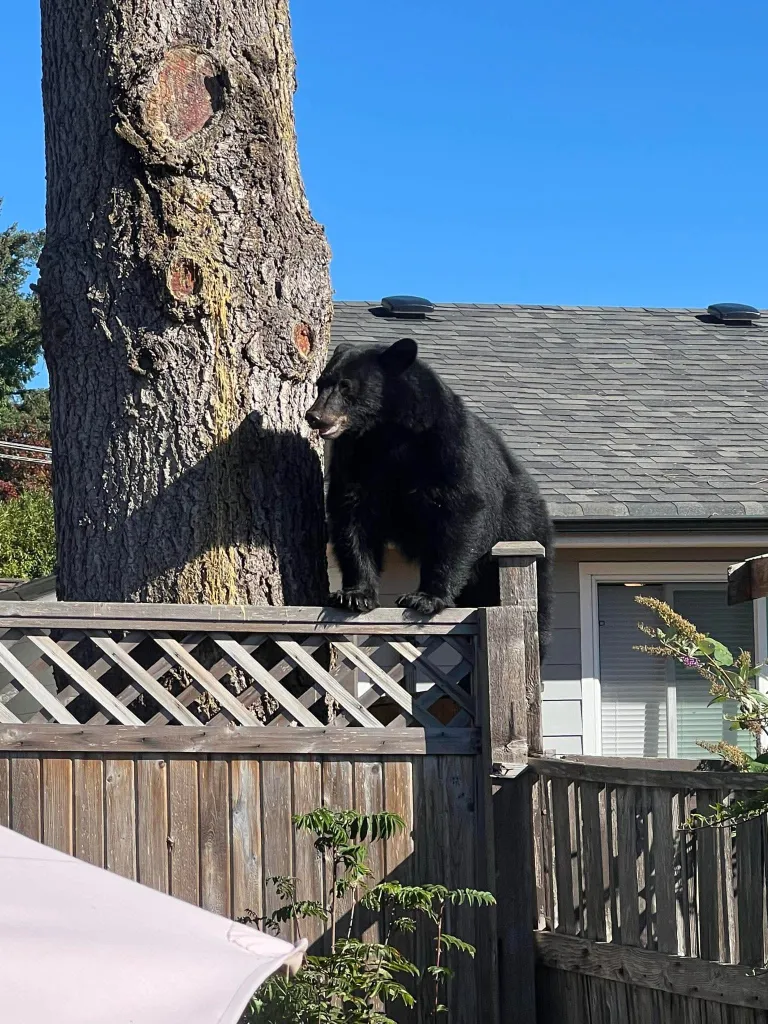A quiet morning in Campbell River turned extraordinary when a black bear was spotted walking across a backyard pergola, balancing on the beams as if it belonged there. The unusual sight quickly spread online, sparking laughter and amazement across social media.
The encounter happened on September 24 in the Merecroft neighborhood, where longtime resident Steve Scherf woke to strange noises outside. At first, he thought raccoons might be exploring his yard. But when he looked closer, he saw a young black bear perched above two potted plants, moving steadily across the wooden lattice. The scene was so unexpected that Scherf reached for his camera to capture the moment.
The bear appeared relaxed as it explored the structure. After pacing on the pergola, it climbed down and wandered into a nearby tree. There, it rested for a short nap before disappearing from view later that day. For Scherf, the event was both humorous and fascinating, a reminder of how close people in Campbell River live to wildlife.
Scherf, a retired biology teacher, offered his own thoughts on why the bear may have come into the area. He believes fallen fruit was the main attraction. Many homes in the neighborhood have apple and plum trees, and during late September much of the fruit is overripe. Some of it may even be fermenting, which often draws wildlife seeking easy calories before winter hibernation. Scherf joked that while the bear had a chance to nibble on his cannabis plants, it ignored them completely and instead seemed interested only in wandering through the yard.
The image he shared online quickly went viral. Social media users responded with humor, praising the bear’s balance and the sturdy build of the pergola. One commenter joked that the animal was already “high enough,” while another remarked that the carpentry was impressive, calling it a true “load-bearing” structure. The playful responses highlighted how a rare wildlife encounter can capture the imagination of thousands.
In the days that followed, another resident of Campbell River reported a similar sighting. A photograph showed what appeared to be the same bear climbing onto a backyard fence, balancing its hind legs on a shorter structure as it pulled itself up. This second photo suggested the young bear may have developed a habit of exploring neighborhood structures, perhaps in search of food or simply out of youthful curiosity.
While the photos brought joy online, experts stress that such encounters are also a reminder of the importance of responsible coexistence with wildlife. Conservation officers warn that autumn is a critical feeding period for bears. As they prepare for hibernation, they spend long hours seeking calorie-rich foods. When fruit trees, compost, or unsecured garbage are available in residential areas, bears may repeatedly return, which increases the risk of dangerous encounters.
The BC Conservation Officer Service advises residents to secure attractants by picking ripe fruit as soon as it is ready, storing unripe fruit indoors, and sharing extra harvests with friends or neighbors. They also recommend ensuring that garbage, compost, and pet food are kept out of reach. Simple steps like these can prevent bears from associating human spaces with easy meals. This, in turn, protects both people and the animals, since bears that become too comfortable around humans often face serious consequences.
Authorities encourage anyone who sees a bear acting unusually or lingering in residential areas to report the sighting. Calls can be made to the Report All Poachers and Polluters (RAPP) hotline, a provincial service that connects directly to conservation officers. Quick reporting allows officers to monitor bear activity and respond if safety becomes a concern.
For Campbell River residents, the pergola incident was both a reminder of their proximity to nature and a moment of unexpected lightheartedness. Scherf’s photo captured not just an animal in an odd position, but also the playful reactions of a community that found humor in the situation. His perspective as a retired teacher added context, showing how small environmental factors like fallen fruit can bring wildlife into urban areas.
Across British Columbia, similar encounters happen every year, but few are as photogenic as a bear balancing on backyard beams. The viral moment demonstrates how quickly a single picture can spread, turning a private surprise into a public delight. It also shows how humor often accompanies wildlife encounters, even when officials remind people of the serious need to reduce attractants.
Black bears remain a common part of life in communities near forests and rivers. Most encounters end harmlessly, as this one did, with the animal wandering away. But experts continue to caution that preventing attractants is key to keeping these interactions safe. When bears learn to forage naturally instead of relying on backyards and garbage bins, they stand a better chance of surviving long term without conflict.
For Scherf, the incident will remain a personal story to tell. His image of a black bear strolling across a pergola is a snapshot of the delicate balance between humans and wildlife in British Columbia. It is also a lasting reminder that even in ordinary neighborhoods, extraordinary moments can happen when nature and people cross paths.

